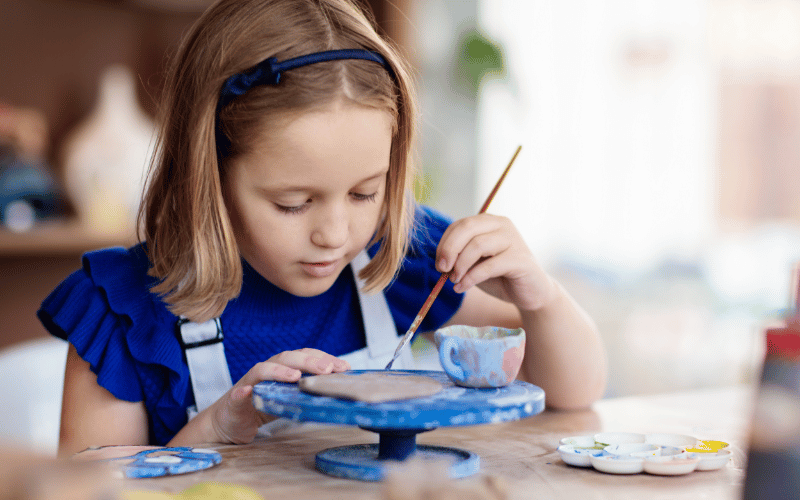The healing power of art cannot be underestimated, especially when it comes to supporting children’s mental health. In a world where children are constantly bombarded with information, the power of art offers a safe space for them to express their emotions and channel their energy in a positive way. In this comprehensive guide, we will explore how art therapy can benefit children’s mental well-being, delve into various creative mediums that can be utilized, and discover effective strategies for implementing art therapy in everyday life. So, let’s dive in and unravel the mysteries of creative expression to support our young ones in their mental health journey.

The Magic of Art Therapy: Unlocking Emotional Resilience
What is Art Therapy and How Does it Work?
Art therapy is a therapeutic approach that uses creative mediums such as painting, drawing, and sculpture to help children explore their emotions, develop self-awareness, and foster coping skills. By providing an avenue for self-expression, art therapy empowers children to process their feelings and find solutions to the challenges they face in life.
The Science Behind the Success of Art Therapy
Numerous studies have shown the effectiveness of art therapy in promoting mental health and well-being. The act of creating art triggers the release of feel-good chemicals in the brain, such as serotonin and dopamine, which help to reduce stress, anxiety, and depression.
The Role of Art Therapy in Developing Emotional Intelligence
Art therapy not only fosters emotional resilience but also helps children develop emotional intelligence. By participating in art therapy sessions, children learn to recognize and understand their emotions, which is a crucial skill for navigating the complexities of life.
Creative Outlets: Exploring Various Art Forms for Emotional Expression
Painting and Drawing: A Colorful Journey to Self-Discovery
Painting and drawing are classic forms of artistic expression that allow children to visually convey their thoughts, feelings, and experiences. Through the use of colors, shapes, and lines, children can communicate their emotions in a way that transcends words.
Sculpture: Shaping Emotions Through Three-Dimensional Art
Sculpture is another powerful medium that encourages children to mold their emotions into tangible forms. Working with clay, wood, or other materials, children can create physical representations of their feelings, providing them with a sense of control and mastery over their emotions.
Collage: Piecing Together the Puzzle of Emotions
Collage is a unique art form that enables children to express their feelings by combining various materials and images. This method encourages children to explore their emotions in a nonlinear, abstract manner, fostering a deeper understanding of their inner selves.
Implementing Art Therapy Strategies in Daily Life
Establishing a Safe Space for Artistic Exploration
To support children’s mental health through art therapy, it’s essential to establish a safe and nurturing environment where they feel comfortable expressing themselves. This may include setting up a dedicated space for artistic activities, providing a variety of art materials, and offering encouragement and validation.
Encouraging Emotional Expression Through Art Prompts
Art prompts can be a valuable tool for inspiring emotional expression in children. These prompts can range from simple suggestions, such as drawing a picture of a recent experience or emotion, to more complex assignments that encourage introspection and self-discovery.
Facilitating Group Art Therapy Sessions
Group art therapy sessions can be a powerful way to foster a sense of community and support among children. These sessions allow participants to share their artwork, discuss their feelings, and learn from one another’s experiences, fostering empathy and understanding.
The Lasting Impact of Art Therapy on Children’s Mental Health
Building Self-Esteem and Confidence
Through Creative Accomplishments Art therapy can play a significant role in boosting children’s self-esteem and confidence. As they develop their artistic skills and create meaningful pieces of art, children experience a sense of accomplishment and pride. This newfound self-assurance can spill over into other areas of their lives, positively impacting their overall well-being.
Promoting Emotional Regulation and Coping Skills
Through the process of art therapy, children learn essential emotional regulation and coping skills. By expressing their emotions through art, they begin to recognize their feelings and develop strategies to manage them effectively. This newfound emotional literacy helps them navigate life’s challenges with resilience and adaptability.
Strengthening Social Bonds and Connections
Art therapy also provides opportunities for children to connect with others on a deeper level. By sharing their artwork and the emotions it represents, they can foster empathetic and supportive relationships with their peers, family members, and therapists. These social connections contribute to a strong support network, vital for maintaining mental health.
Conclusion: Empower the Next Generation Through the Healing Power of Art
In conclusion, the healing power of art is an invaluable resource for supporting children’s mental health. By utilizing creative expression through various art forms, art therapy can help children develop emotional resilience, self-awareness, and coping skills necessary for a healthy and fulfilling life. By implementing art therapy strategies in daily life and fostering a nurturing environment for self-expression, we can empower our children to navigate the complexities of their emotions and unlock their full potential. So, let’s embrace the transformative power of art and support the mental well-being of the next generation.